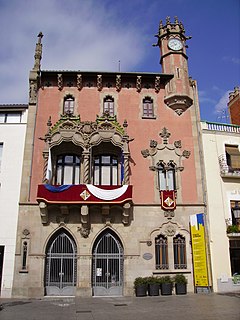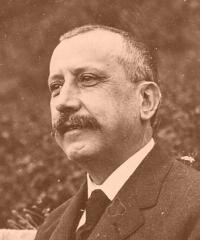Related Research Articles

The Trambaix is one of Barcelona's three tram systems. It is operated by TRAMMET connecting the Baix Llobregat area with the city of Barcelona, Catalonia, Spain. It opened to the public on 5 April 2004 after a weekend when the tram could be used free of charge.

Granollers is a city in central Catalonia, about 30 kilometers northeast of Barcelona. It is the capital and most densely populated city of the comarca of Vallès Oriental.

Sant Julià de Lòria is one of the parishes of Andorra, in the far south of that country. It is also the name of the main town of the parish, which at 908 m is the lowest settlement in Andorra. Other settlements in the parish include Bixessarri, Aixàs, Aixovall, Certers, Llumeneres, Nagol, Aixirivall, Auvinyà, Juberri, Fontaneda, and Canòlic. It is bordered by Andorra la Vella in the north, Escaldes-Engordany in the northeast and Catalonia, Spain in the south, east, west, northwest, southwest and southeast.

Sant Adrià de Besòs is a city and a municipality within the comarca of Barcelonès in Catalonia, north-eastern Spain. It is situated on the Mediterranean coast, at the mouth of river Besòs, extending to both sides of the estuary although the original settlement with the parish church lies on the left bank of the river, in the northern part of town. Sant Adrià is the smallest municipality of Barcelonès and has close ties with the neighbouring cities of Barcelona, Badalona and Santa Coloma de Gramenet, forming a uniform urban area within Barcelona metropolitan area.

Piera is a municipality that covers a large portion of the southeastern corner of the comarca of Anoia in Catalonia, Spain, on the left bank of the Anoia river. The agricultural land, mostly non-irrigated, is used for the cultivation of cereals, grapes, olives and almonds. The town itself hosts a number of light industries: textiles, plastics and construction materials. Tourism during the summer months is also relatively important for the local economy.

Xàtiva is a town in eastern Spain, in the province of Valencia, on the right (western) bank of the river Albaida and at the junction of the Valencia–Murcia and Valencia Albacete railways. It is located 25 km west of the Mediterranean Sea. During the Al-Andalus Islamic era, Arabs brought the technology to manufacture paper to Xàtiva. In the 12th century, Xàtiva was known for its schools, education, and learning circles. Islamic scholar Abu Ishaq al-Shatibi's last name refers to Xàtiva where he lived and died. After the Reconquista by Northern Christian Kingdoms and the following Christian repopulation the city became the cradle of one of the most powerful and controversial families of the Renaissance, this was the House of Borgia, which produced Popes like Callixtus III and Alexander VI.

Montblanc is the capital of the Catalan comarca Conca de Barberà, in the Spanish province of Tarragona. The Prades Mountains are located in the vicinity of this town.

Vilafranca del Penedès, or simply Vilafranca, is the capital of the comarca of the Alt Penedès in Catalonia, Spain. The Spanish spelling of the name, Villafranca del Panadés, is no longer in official use since 1982. It is situated in the Penedès Depression on the left bank of the Foix River, and on the main axis of communication from Barcelona to Tarragona and Valencia, served by a Rodalies Barcelona line 4 and by the AP-7 autopista as well as by the C-243 towards Sant Sadurní d'Anoia, and C-15 roads to Vilanova i la Geltrú and Igualada respectively.

Alella is a village in the comarca of Maresme in Catalonia, Spain. It is situated on the coast on the southwest side of the granite Litoral range. The town is known for its wines, cava and perfumes, but is also a commuter town for nearby Barcelona.

Sant Celoni is a municipality in the comarca of the Vallès Oriental in Catalonia, Spain. It is situated in the valley of the Tordera river between the ranges of Montseny and Montnegre. The main part of the town is on the left bank of the river. The former municipalities of Montnegre and Olzinelles now form part of the municipality of sant Celoni, which has the largest area in the comarca. The municipality is served by the AP-7 Motorway and the C-251 road, as well as by a station on the RENFE railway line between Barcelona and Girona.

Via LaietanaVía Layetana in Spanish, is a major thoroughfare in Barcelona, Catalonia, Spain, in the Ciutat Vella district. The avenue runs from Plaça Urquinaona to Plaça d'Antonio López, by the seafront, and separates the neighbourhoods of the old city it has on either side: La Ribera/El Born and Sant Pere on one and Barri Gòtic on the other. Besides being always overcrowded with both locals and tourists attracted by its Modernista Art Nouveau, Art Déco, and Noucentista neo-classical architecture, in addition to its nearness to the Ramblas and the quiet pedestrian streets of Barri Gòtic, Via Laietana hosts the headquarters of a number of banks and institutions.

Santa Maria de Montserrat is an abbey of the Order of Saint Benedict located on the mountain of Montserrat in Monistrol de Montserrat, Catalonia, Spain. It is notable for enshrining the image of the Virgin of Montserrat. The monastery was founded in the 11th century and rebuilt between the 19th and 20th centuries, and still functions to this day, with over 70 monks. There have always been roughly 80 monks in residence.

Plaça de Francesc Macià is a square in Barcelona, Catalonia, Spain. Located in one of the main business areas of the city, it is one of the most transited points of Barcelona. It is crossed by Avinguda Diagonal and several other major thoroughfares: Avinguda de Josep Tarradellas, Travessera de Gràcia, Carrer del Comte d'Urgell and Avinguda de Pau Casals. It is part of the Sarrià-Sant Gervasi district, even though it borders two other districts of Barcelona: Les Corts and Eixample.

El Ràfol d'Almúnia is a municipality in the comarca of Marina Alta in the Valencian Community, Spain.

Joan Rubió y Bellver was a Spanish architect famous for his contributions to the Catalan Modernista movement.

Rubió is a rural municipality in the comarca of Anoia in Catalonia, Spain. Its administrative centre is the village of Rubió, and other villages include Maçana and El Pla de Rubió. As of 2014, the municipality had 228 inhabitants. At 48 square kilometres (19 sq mi) it is one of the largest municipalities of the Alta Segarra, and at one time was the most sparsely populated.

Sant Francesc Xavier or Sant Francesc de Formentera is a village and capital and largest settlement of Formentera, Balearic Islands, Spain. It includes a cultural centre so visitors can learn about the village's history throughout the history of Formentera.

Francisco de Paula del Villar y Lozano was a Spanish architect.

The Church of Saint Philip Neri is a baroque-style church located in the Plaça de Sant Felip Neri, in the Gothic quarter of Barcelona, Catalonia, Spain. It was built between 1721 and 1752. During the Spanish Civil War, on January 30, 1938, it was bombarded by Franco's air forces. The church has a convent annex belonging to the Oratory of Saint Philip Neri.